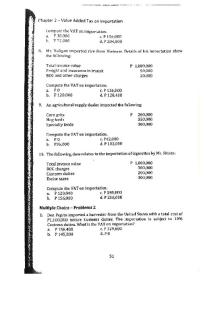Anemia 3 - Lecture notes 3 PDF

| Title | Anemia 3 - Lecture notes 3 |
|---|---|
| Course | Medical Technology |
| Institution | Notre Dame of Marbel University |
| Pages | 6 |
| File Size | 432.2 KB |
| File Type | |
| Total Downloads | 27 |
| Total Views | 282 |
Summary
Bone marrow failure Aplastic Anemia Pure Red Cell Aplasia Congenital Dyserythropoietic Anemia Myelophthisic Anemia Anemia of Chronic Kidney Disease Bone marrow failure: reduction of cessation of blood cell production affecting one or more cell lines. o Pancytopenia is always seen Destruction of hema...
Description
HEMATOLOGY Aplastic anemia
Bone marrow fai failure lure -
Aplastic Anemia Pure Red Cell Aplasia Congenital Dyserythropoietic Anemia Myelophthisic Anemia Anemia of Chronic Kidney Disease
History of Aplastic Anemia -
-
Bone marrow failure: reduction of cessation of blood cell production affecting one or more cell lines. o Pancytopenia is always seen
1.
Destruction of hematopoietic stem cells
-
drugs, chemicals, radiation, viruses or autoimmune mechanisms.
2. Premature senescence and apoptosis of HSCs - mutations 3. Ineffective hematopoiesis: stem cell mutations and Vit B12 or Folate deficiency 4. Decreased production of hematopoietic GF 5. Disruption of BM microenvironment that supports hematopoiesis. 6. Loss of normal hematopoietic tissue due to infiltration of abnormal cells
Characterized by: thrombocytopenia: significant bleeding, decreased RBC count and Hgb: fatigue, neutropenia: risk of bacterial and fungal infections
-
Paul Ehrlich (1854-1915) described the first case of aplastic anemia in a pregnant woman who died of marrow failure in1888. A fatal BM syndrome o Pancytopenia, reticulocytopenia, BM hypocellularity and depletion of HSCs The term “aplastic anemia” was given to the disease by Vaquez and Aubertin in 1904.
Acquired aplastic anemia -
More common 70% idiopathic 10-15% secondary Macrocytic or normocytic anemia with reticulocytopenia
etiolo etiology gy Etiology Acquired: (idiopathic, secondary to) Drugs Agents with predictable, doserelated effects (e.g., chemotherapeutic drugs) - Agents with unpredictable, nondose-related effects (e.g., chloramphenicol) o Cytotoxic drugs o Antibiotics -
HEMATOLOGY Chloramphenicol Anti-inflammatory Anti-convulsant Sulphonamides 2-3 months usually between exposure and the development of aplastic anemia. Supress BM Radiations Chemicals e.g., Benzene and pesticides Viruses: o Hepatitis A, Non-A and NonB o Herpes simplex, E-B virus o Parvovirus: Transient o 2-3 months between exposure to the virus and the development of AA. Immune: SLE, RA (rheumatoid arthritis), Pregnancy Idiopathic: 70% o o o o o
-
-
-
Severe depletion of HSC and Progenitor cells may be due to: 1. Direct damage to stem cells: drugs, chemicals etc. 2. Immune mechanism damage to stem cells
clinical findings Clinical findings -
-
-
-
CD 34 cells 10x lower than that with healthy people.
Anemia: pallor, fatigue and weakness Severe anemia: cardiac complications, cardiac failure and death Petechiae, bruising, epistaxis, bleeding gums, menorrhagia and bleeding disorders. Fever and bacterial infectionsneutropenia
laboratory findings findings Laboratory -
pathophysiolog pathophysiologyy Pathophysiology
Production of GF is normal-support growth of CD34 cells. EPO, TPO, G-CSF, GM-CSF all increase-compensate pancytopenia
-
Pancytopenia Hgb...
Similar Free PDFs

Anemia 3 - Lecture notes 3
- 6 Pages

3 - Lecture notes 3
- 7 Pages

Notes#3 - Lecture 3 notes
- 49 Pages

Lecture notes, lecture 3
- 8 Pages

Lecture notes, lecture 3
- 5 Pages

Lecture notes, lecture 3
- 59 Pages

Chapter 3 - Lecture notes 3
- 1 Pages

Chapter 3 - Lecture notes 3
- 30 Pages

Chap 3 - Lecture notes 3
- 4 Pages

CIV1000 - 3 - Lecture notes 3
- 4 Pages

Chapter 3 - Lecture notes 3
- 6 Pages

Chapter 3 - Lecture notes 3
- 6 Pages

Tema 3 - Lecture notes 3
- 2 Pages

Tema 3 - Lecture notes 3
- 4 Pages

Chapter 3 - Lecture notes 3
- 45 Pages

Week 3 - Lecture notes 3
- 1 Pages
Popular Institutions
- Tinajero National High School - Annex
- Politeknik Caltex Riau
- Yokohama City University
- SGT University
- University of Al-Qadisiyah
- Divine Word College of Vigan
- Techniek College Rotterdam
- Universidade de Santiago
- Universiti Teknologi MARA Cawangan Johor Kampus Pasir Gudang
- Poltekkes Kemenkes Yogyakarta
- Baguio City National High School
- Colegio san marcos
- preparatoria uno
- Centro de Bachillerato Tecnológico Industrial y de Servicios No. 107
- Dalian Maritime University
- Quang Trung Secondary School
- Colegio Tecnológico en Informática
- Corporación Regional de Educación Superior
- Grupo CEDVA
- Dar Al Uloom University
- Centro de Estudios Preuniversitarios de la Universidad Nacional de Ingeniería
- 上智大学
- Aakash International School, Nuna Majara
- San Felipe Neri Catholic School
- Kang Chiao International School - New Taipei City
- Misamis Occidental National High School
- Institución Educativa Escuela Normal Juan Ladrilleros
- Kolehiyo ng Pantukan
- Batanes State College
- Instituto Continental
- Sekolah Menengah Kejuruan Kesehatan Kaltara (Tarakan)
- Colegio de La Inmaculada Concepcion - Cebu